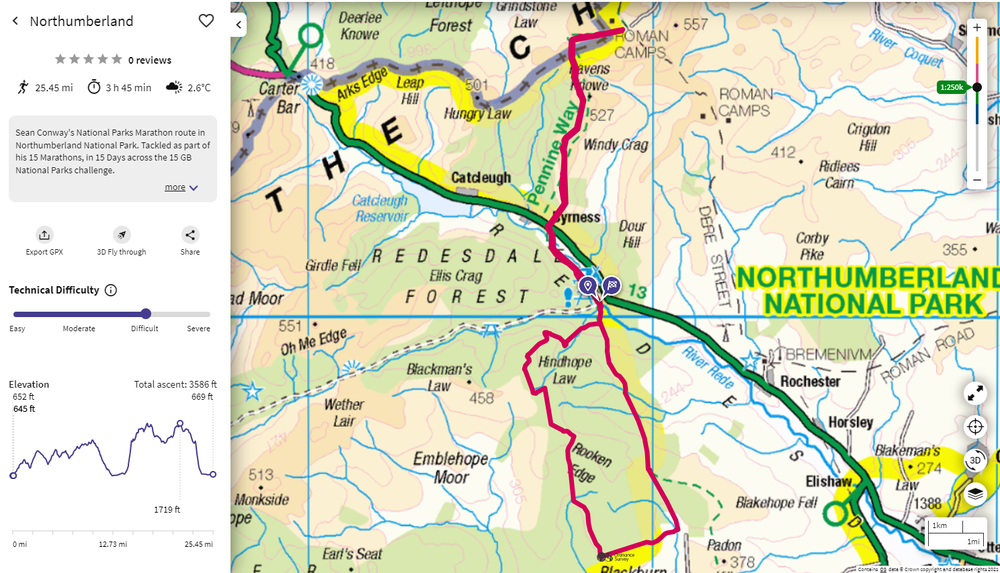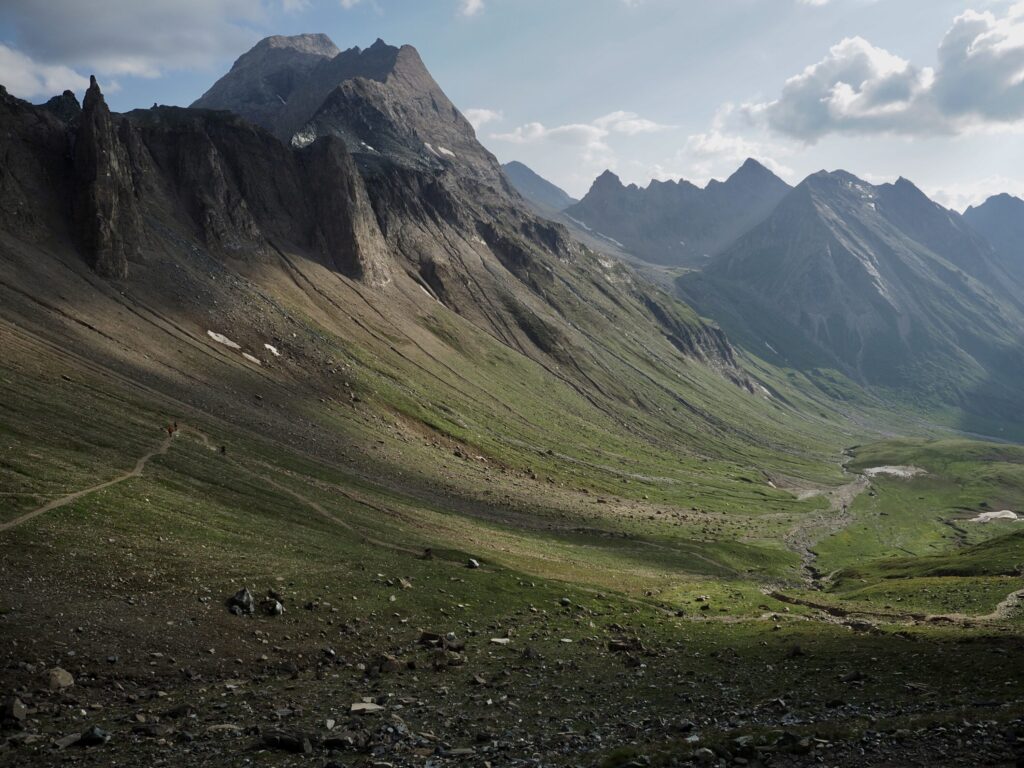In this three-part series in partnership with OS Maps, we take a closer look at GetOutside Champion Sean Conway’s National Parks Challenge — which saw him take on 15 marathons in 15 National Parks in 15 days — to learn what it takes physically and mentally to complete such a challenge and discover some of his highlights along the way.
Having completed a marathon in the Cairngorms and Loch Lomond and The Trossachs National Park in part 1, we catch up with Sean again as he continues his journey south and across the border into England. You’ll also find details for each of the routes Sean ran to take them on yourself.

Reality Bites
Despite a ruthless ability to chase the distance, as Sean Conway chipped away at 15 back-to-back marathons, across some of the most challenging landscapes the UK has to offer, the tax man would never be far from his heels. Succumbing to exhaustion, it seemed, was surely just a matter of time.
‘Running is so hard. Even the fittest people in the world get injured while running,’ explains Sean. ‘That meant I needed to work on injury prevention, which just means putting in the time on the legs. But for the National Parks project, it wasn’t about staying injury-free, it was about knowing the difference between a long term injury and what’s just a niggle.’
Making his way south through the United Kingdom, one marathon at a time, Sean was steadily racking up the distance. Five deep with over 130 miles under his belt, without proper facility or opportunity to recover, the enormity of the challenge was starting to stack against him.
‘The driving took its toll on my recovery and the middle five were really tough. I had really tight muscles that were pulling my knee all over the place,’ he remembers. ‘In England I found the Norfolk Broads the hardest. Being entirely flat meant I didn’t walk much. On the hilly routes of Northumberland, the Dales or on Exmoor, I’d walk the steep sections and use different muscles but on the flat you just pound the knees all day. That was hard. Also when it’s flat, you can see how far you need to run and that was tough on the mind.’
By the time he had reached the south of England, the accumulative strain on Sean’s body and mind aligned perfectly with the hottest days of summer. With seven marathons still to run, he knew he’d have to dig deeper.
‘Growing up in Africa means I quite like the heat so it doesn’t stress me out, but my performance goes down drastically,’ says Sean. ‘When it got really hot, I needed to drink about six litres of water a day and make the effort to really increase my salt intake. To drink that much, of course I needed to carry more water which means I ran slower which means I’m out longer which means I need more water again. It was a downhill spiral from there.’



Having so many people join me really spurred me on. The ultra-running crowd is such a good bunch of people
The Power of Community
Anyone who has dipped as much as a toe into endurance sport or even a long day on the hill knows the loneliness of the pursuit. Add to that a niggling injury, exhaustion, a battle with dehydration and the small issue of seven marathons still ahead of him, and the sense of isolation amid the task at hand, saw Sean depleted and lacking motivation.
Luckily, the running community had his back. In the South Downs, about 40 local runners who’d been following his progress online showed their support by joining him out on the trails of their local hills. Something he still remains thankful for today.
‘They came at the perfect time, I was struggling with the mileage a few days before that and my right knee was in pain. But having so many people join me really spurred me on. The ultra-running crowd is such a good bunch of people,’ he says. ‘I was worried that I’d spend the entire marathon answering the same questions and getting bombarded, but everyone just actually wanted to come and run. It was great! And the few people who did want to chat, we landed up having some fabulous conversations about anything and everything. I even ended up getting a massage from a runner that came to join me and that helped a lot.
‘Before these marathons I’d have done anything to avoid running in groups. I love running on my own, and I still do, but I now also really appreciate running with other like-minded people.’

Northumberland
Northumberland National Park is the least populated of all the Parks in England and Wales with a population of about 2,000 people. That’s only two people per square kilometre.
Location: Running south from Blakehopeburnhaugh Waterfall and then looping back too the falls. Then heading north along the Pennine Way and then back again.
Start point: Blakehopeburnhaugh Waterfall (compulsory swim after)
Terrain: All trail.
Food/Water: Refuel back at your car after lap one

Lake District
England’s quintessential national Park, the Lake District is home to the country’s highest mountains as well as the deepest and largest natural lakes in England, Wastwater and Windermere respectively.
Location: Starting in Keswick and run three laps of Derwentwater. Each lap is 14km
Start point: Moot Hall, Keswick High Street
Terrain: Mostly trail except short section along public road.
Food/Water: Resupply in Keswick on each lap
View Sean’s Lake District marathon, here.

Yorkshire Dales
Up hill and down dale, the river valleys and rolling hills of the Yorkshire Dales National Park are home to some of Yorkshire’s most iconic scenery while underneath them, lay one of the UK’s most extensive caving systems.
Location: Starting in Bainbridge, head west along the old Roman Road then do a long 25km loop round and back to Bainbridge. Then a shorter 16km second loop via Semerwater and back to Bainbridge.
Start point: Bainbridge playground
Terrain: Mostly trail. Some short sections on backroads.
Food/Water: Resupply after first long loop at Bainbridge.
Towns and villages to visit in the Yorkshire Dales.

North York Moors
Located just a stone’s throw to the east, the North York Moors is contains of the UK’s largest expanses of heather moorland, leading to the impressive cliffs which line the North Sea.
Location: This is an out and back along the Cleveland Way.
Start point: Car park at the top of Low Town Bank Rd.
Terrain: All trail.
Food/Water: Resupply available halfway.

Peak District
The UK’s original and most visited national park, squeezed between the Sheffield and Manchester, Peak District provides an escape to the outdoors for millions.
Location: This is a three lap run heading along Curbar Edge and then back down below along the River Derwent.
Start point: Curbar Edge Car Park
Terrain: Mostly trail. Short road sections.
Food/Water: Resupply at vehicle on each lap.

Norfolk Broads
Set amongst big skies and wavering reeds the Broads are a 125 mile network of man-made lock-free waterways
Location: From Reedham, head east towards Great Yarmouth then head back towards Reedham. This route is slightly over a marathon at 44km.
Start point: Outside The Lord Nelson Pub
Terrain: Mostly trail with about 15km of backroad.
Food/Water: Resupply at Great Yarmouth at 17km.

South Downs
The newest and the most populous of the UK’s 15 national parks, The South Downs is one of just 16 International Dark Sky Reserves in the world making it one of the best places in the country to view the night sky.
Location: From Cheesefoot Head and then run two laps of the route.
Start point: Cheesefoot Head Car Park
Terrain: A mixture of road and trail.
Food/Water: Resupply at your car after lap one.

New Forest
A mix of ancient woodlands and open habitats, the New Forest is famed for once being William the Conqueror’s hunting forest and today is one of the largest remaining tracts of unenclosed pasture land, heathland and forest in Southern England.
Location: Start the run from Lymington and do an out and back via Hurst Castle
Start point: Bath road Car Park
Terrain: Trail with some road
Food/Water: Resupply at Milford on Sea at around 15km and then again at 25km on the way back.

Dartmoor
Located in South Devon, Dartmoor’s moorland landscape is capped with exposed granite hilltops known as tors. While parts of the moor have been used as military firing ranges for over 200 years, due to the Dartmoor Commons Act 1985, much of Dartmoor has no restrictions on where walkers can roam and in many cases wild camp.
Location: From Bennet’s Cross car park and do three laps into the moor and back.
Start point: Bennett’s Cross Car Park on B3212
Terrain: All trail
Food/Water: Resupply at your car on each lap

Exmoor
Home to the source of the River Exe, Exmoor’s hilly open moorland lines parts of the North Devon and West Somerset coast with dramatic cliff tops and far reaching views.
Location: Start the run from Porlock and head west along the coast path and then back to Porlock. The second lap goes east to Minehead and then back to Porlock.
Start point: The Ship Inn
Terrain: Almost entirely trail.
Food/Water: Resupply at Porlock and then again at Minehead not he second lap.
Don’t miss a single adventure
Sign up to our free newsletter and get a weekly BASE hit to your inbox
Other posts by this author

Story • Chris Hunt • Jul 04, 2023
Evolution of Flow: E-mountain Biking in the Swiss Alps
Exploring Crans Montana and the Tièche valley on two wheels

Story • Chris Hunt • May 05, 2023
Life-affirming discoveries near Bolivia’s Death Road
Sami Sauri explores the winding gravel tracks of the Yungas surrounding La Paz, Bolivia


Story • Chris Hunt • Feb 09, 2023
Throat of The Dog: Bikepacking the Zillertal Alps
A 175km traverse of the mountainous spine between Italy and Austria
You might also like

Video • BASE editorial team • Aug 03, 2022
No rules, No spectators
A 340-mile unsanctioned solo race from Santa Monica to Las Vegas

Interview • Ilona Cabral • Jul 27, 2022
Summit to City
An audacious expedition to climb Kanchenjunga and set the fastest-known-time along the Great Himalayan Trail







